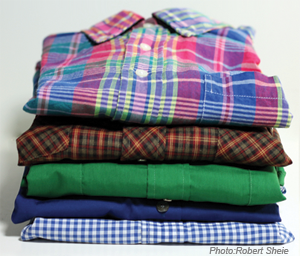 By Lindsay Dahl, Deputy Director
By Lindsay Dahl, Deputy Director
Don’t we all like to feel fashionable from time to time? This week thousands
have gathered in New York City for Fashion Week, and what a better time to talk
about the price we often pay for our fashionable clothes. <<Big
groans>> Debbie Downer is at it again! – Don’t worry, there’s some pretty
awesome news at the end of this post.
So just how pervasive are toxic chemicals in the clothing and textile
industry? Toxics are showing up in all parts of the supply chain of textiles,
in the production and manufacturing, the clothes themselves, and our routine
cleaning of garments.
Why is this
happening?
Before we get into other ways our clothing is affected by toxic
chemicals, it begs the question: why is this happening? In the U.S.
we have weak, lame
laws on toxic chemicals. Due to these weak laws, companies can use
whatever chemical they like to make our clothes (other products and during the
manufacturing process.) That is why we’re asking Congress to get tough on toxic
chemicals and pass the Safe Chemicals Act (take action
now!)
Toxics in the
production & manufacturing of clothes
The dyes used to color our chic blouses and dark blue jeans can be
harmful to the environment and drinking water. According to NRDC, “Textile manufacturing has a huge environmental
footprint, polluting as much as 200 tons of water per ton of fabric with a
suite of harmful chemicals, and consuming tremendous amounts of energy for
steam and hot water.” You can read their Clean by Design report for more information.
Toxics in
clothes
- Major sportswear companies like the North
Face and Patagonia came under pressure to remove the toxic PFCs (the Teflon
chemical) from their high performance jackets, pants and other clothing items. The
PFCs are used to repel water and other liquids, certainly we can do that
without toxic chemicals! Our factsheet
on PFCs outlines some of the health and environmental concerns with this
chemical. - Jeans, t-shirts, and jackets from major
brands tested positive for nonyphenol ethoxalates (NPEs), a chemical shown to
break down into hormone disrupting chemicals in the environment. Although there
is no direct evidence of harm caused by wearing these pieces of clothing, we know
that exposure to our skin and the environment is not a good thing. To see a
list of some of the products found to have this toxic chemical you can read the
Toxic Threads results here. - Popular “wrinkle-free” shirts are often treated
with formaldehyde (and so are wrinkle-free sheets.) - Phthalates were found in popular brands of t-shirts,
and even women’s
underwear by Victoria’s Secret. - Pesticides are often
used in transportation of clothing from overseas, so be sure to wash new
clothes before wearing them.
Companies
moving in the right direction
The good news is that thanks to Greenpeace’s “Detox Campaign” many
major fashion brands have agreed to move away from toxic chemicals in their
supply chain (Nike, Adidas, Puma, H&M, M&S,
C&A, Li-Ning,
Zara, Mango, Esprit, Levi’s,
Uniqlo,
Benetton
and Victoria’s Secret).
According to Greenpeace, here is what these brands have agreed to do:
Zero
discharge of all hazardous chemicals – Eliminate toxic discharge (which
is very common in the fashion and textile industry) through waste water pipe
discharge, solid waste and air pollution.Prevention
and Precaution – These companies have agreed to move away from
chemicals shown to cause harm, even in the face of scientific uncertainty and
replace them with safer substitutes. What a concept!Right to know –
The brands agree to publicly disclose information about the hazardous chemicals
used and discharged when making their products.
We hope to both educate consumers about health and environmental risks
of toxic chemicals all throughout the supply chain, while give you some tips to
protect yourself. But please remember that the burden should not fall on our
shoulders to find clothing free of toxic chemicals.
We need strong laws on toxic chemicals that remove the burden from consumers
and instead put the responsibility on chemical manufacturers to produce safer
chemicals. Please join us in asking your Senators
to co-sponsor the Safe Chemicals Act today.
For more information on Greenpeace’s
Detox Campaign
Follow Lindsay on Twitter: @Lindsay_SCHF



